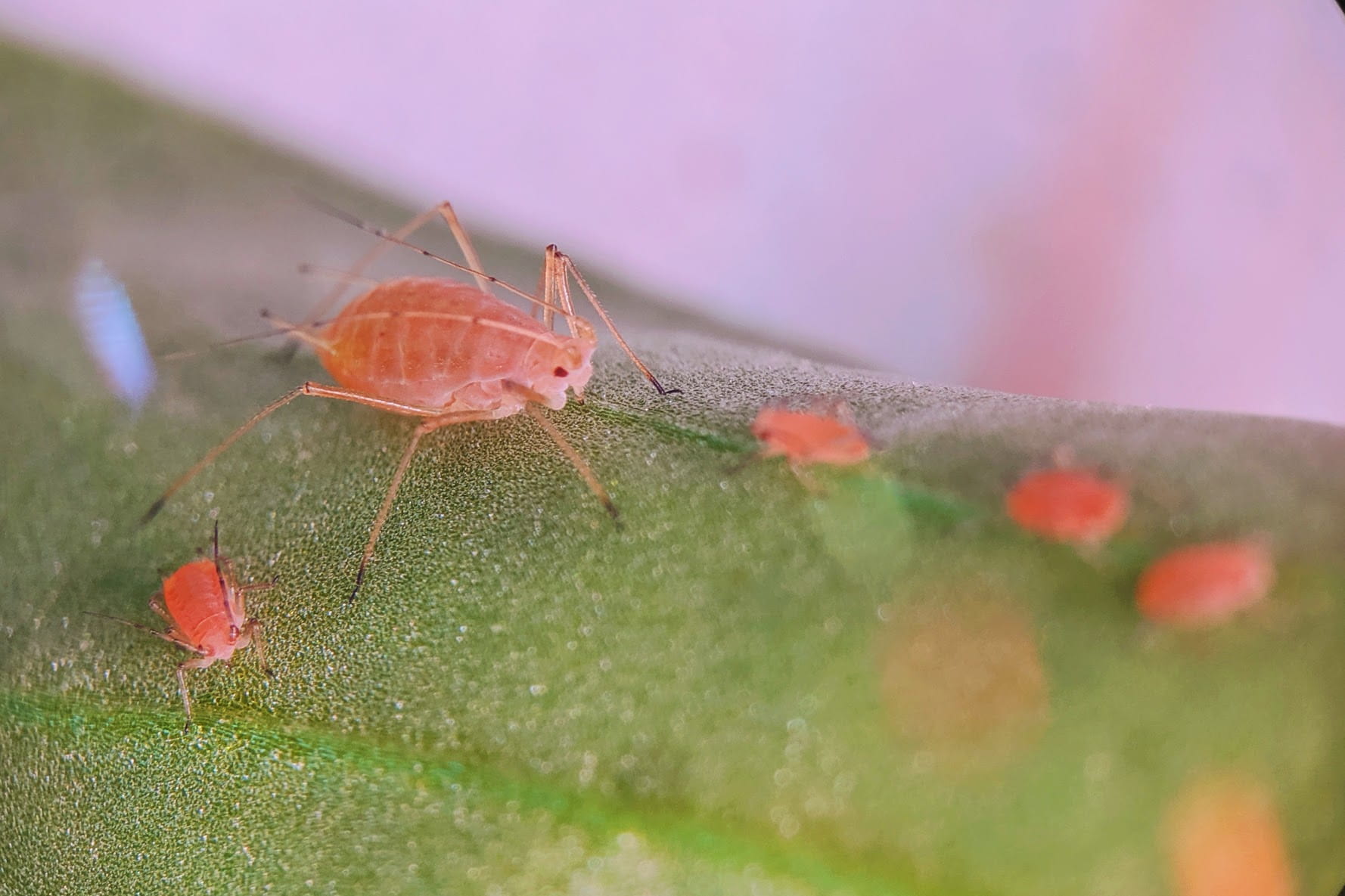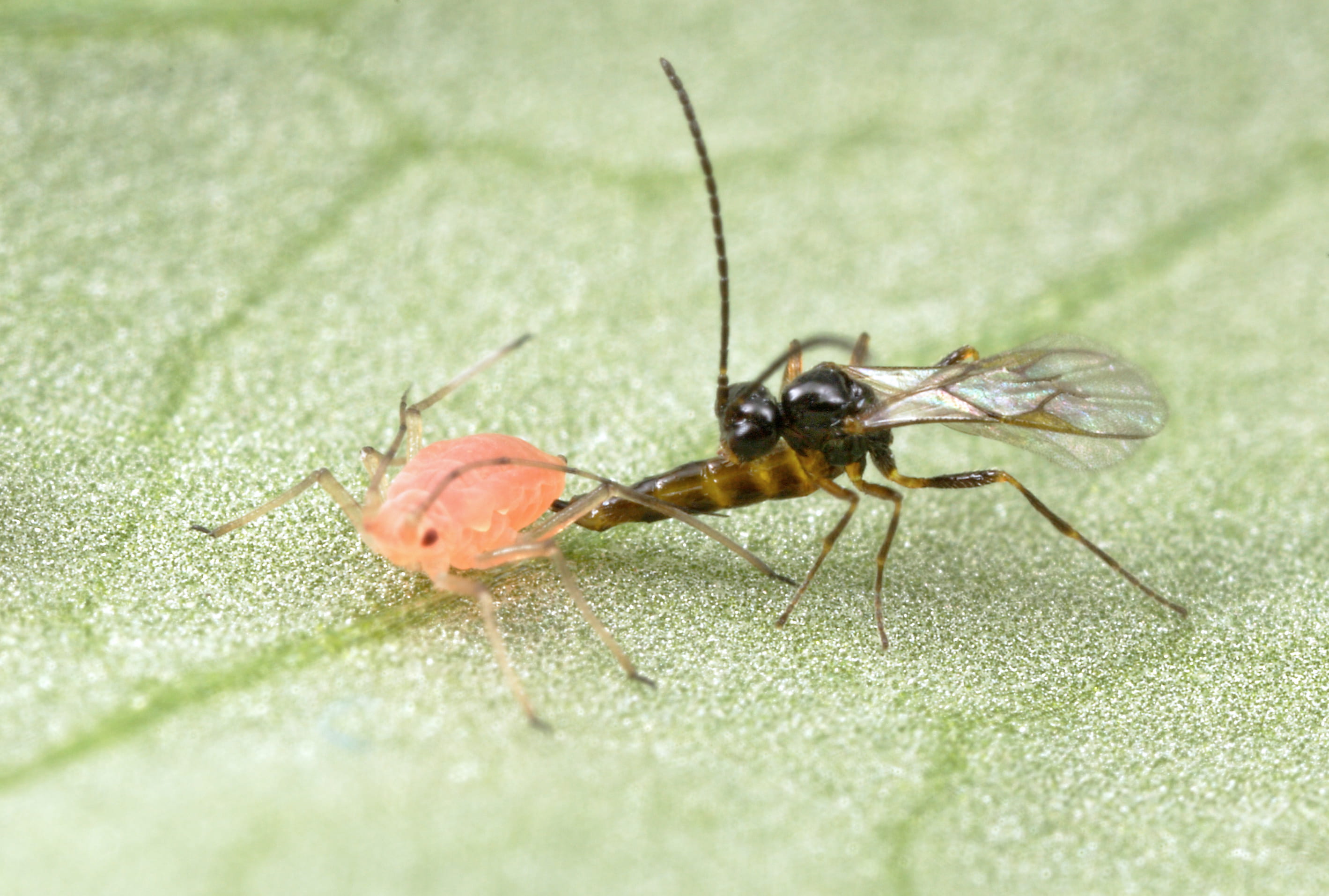Defense Mechanisms in Aphids Can Become a Double-edged Sword, Sharpened by the Seasons

- How and When Could AI Be Used in Emergency Medicine?
- Faculty Highlights: Recent Awards and Grants
- Drexel Receives $1.4 Million Grant to Establish Hub for Literacy Reform
- Drexel Public Health Researchers Lead $3.7 Million Study Looking at Impact of Federal Housing Assistance on Health Care for Chronic Conditions

Researchers at Drexel are studying pea aphids to understand how temperature and seasonality can be driving forces in evolution. (Photo credit: Drexel University/Linyao Peng)
Evolution is unfolding in real time within many natural animal populations and researchers are now observing how this influences biodiversity in the field. In a newly published study in Molecular Ecology a team of Drexel University scientists examined the biological variations in pea aphids, insects that reproduce frequently enough to evolve before our eyes, by tracing the prevalence of their protective endosymbiont, Hamiltonella defensa, which the insects use to ward off parasitoid wasps.
“We know that certain organisms have many generations in a season, and we know sometimes it just takes a handful of generations for evolution to unfold; and aphids are one of those types of organisms,” explained Jacob A. Russell, PhD, a professor in the College of Arts and Sciences, and senior author on the study.
Like many insects, aphids play host to symbiotic bacteria – or endosymbionts – in their blood and internal tissues. While their full range of impacts is not yet understood, these bacteria typically provide some defense against environmental pressures, like parasites and parasitoids – parasites that kill their hosts. Hamiltonella defensa, the endosymbiont focused on in this study, for instance, wards off parasitoids in pea aphids. But these bacteria are also of interest to researchers because they are heritable — passed on from females to their offspring.
“In essence, these bacteria are inherited like mitochondrial DNA and because of this, they can serve as part of the pea aphid's adaptive arsenal, acting alongside the many thousands of genes in this sap-feeding insect's genome,” said Russell.
Andrew Smith, PhD, a former Drexel graduate and current Rodale Institute Chief Scientist, led the research efforts that enabled the biologists to get a closer look at the natural forces shaping Hamiltonella prevalence. It was their hope that, through repeated field collections and routine molecular screening, they could shed light on the evolutionary forces affecting aphids in real time.
“We were motivated to try to understand why this one endosymbiont is maintained in these populations, why is it never lost and why it doesn’t just go to 100% frequency,” said Russell. “One idea is there must be some times when it helps the aphid, as well as times when it is slightly harmful.”
To supplement their aphid collection and endosymbiont screening, the field team studied a range of environmental variables within the same alfalfa fields, including the prevalence of Aphidius ervi, a parasitoid wasp introduced in the United States to control populations of the pea aphid, which was once a threat to crops, including alfalfa. The wasps kill aphids by laying eggs inside them. Intriguingly, Hamiltonella endosymbionts prevents young wasp development, but they also come with a cost, according to the researchers.
“There’s this ‘rent’ that the aphid has to pay to the endosymbiont just to sustain its populations,” said Russell. “In the lab, we initially thought the aphids with the endosymbiont would be worse off than the aphids that did not have the endosymbiont due to this ‘rent’ concept.”

This concept, that aphids with Hamiltonella endosymbionts were worse off than those without them in the absence of the wasps, was supported by prior lab experiments. But despite this expectation, the authors found no significant relationship between wasp prevalence and endosymbionts. But they did see aphid populations evolving over time – with the endosymbiont’s prevalence shifting rapidly, on several occasions. Correlating most clearly with these shifts was the temperature of the aphids’ surrounding environment.
Their results suggest “the cost of ‘rent’ is higher for aphids harboring these endosymbionts when it’s cool,” said Russell, who thinks “it’s actually pretty useful for the aphids to have these endosymbionts when it’s warm.”
The authors conclude that the endosymbiont’s dynamics, and hence real time evolution of the pea aphid, likely result from an evolutionary phenomenon known as “balancing selection,” which happens due to changing costs and benefits of harboring the endosymbiont at different temperatures.
This would render Hamiltonella as a fair weather friend, useful when it’s warm, and harmful when it’s not. Though the mechanism of this seasonality remains undetermined, their results suggest that temperature could serve as a major factor in conjuring the occurrence of Hamiltonella endosymbionts in aphids.
This discovery was only possible because the team made its observations in the field. “We tend to do our lab experiments in these pretty one-dimensional lab environments and temperature is held constant,” said Russell, “so those lab findings might not be fully transferable,”.
This work provides one of the first examples of a study on seasonal insect adaptation that’s enabled not by variation in insect genes, but by variation in their endosymbionts. As such, it is among the first to show that maternally transmitted microbes – found in most insect species – respond to the pendulum-like nature of changing environments across the seasons.
Given the longer-term trends in global climate, it is possible, too, that endosymbionts may govern the future success of insect species in our rapidly warming world.
In This Article
Contact
Drexel News is produced by
University Marketing and Communications.